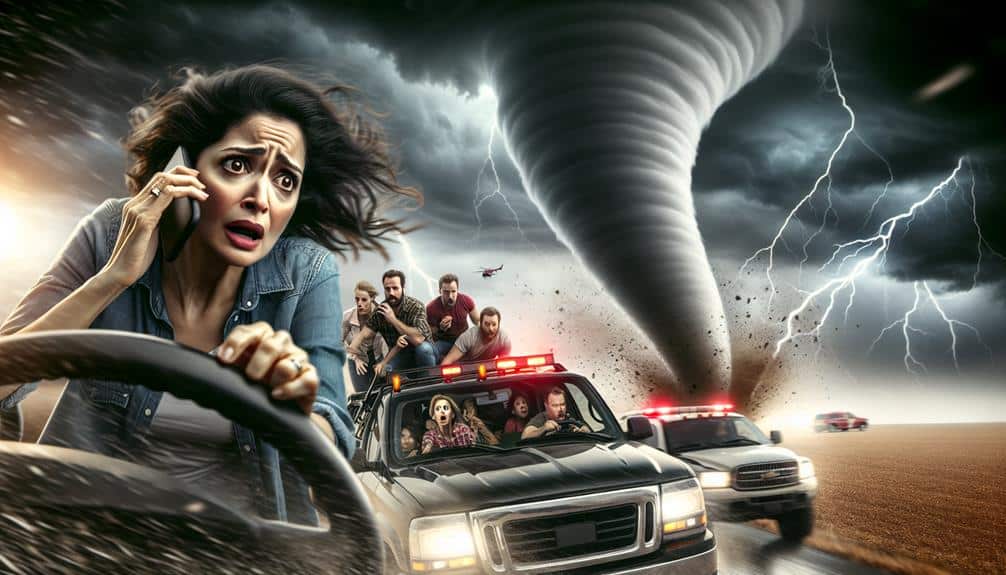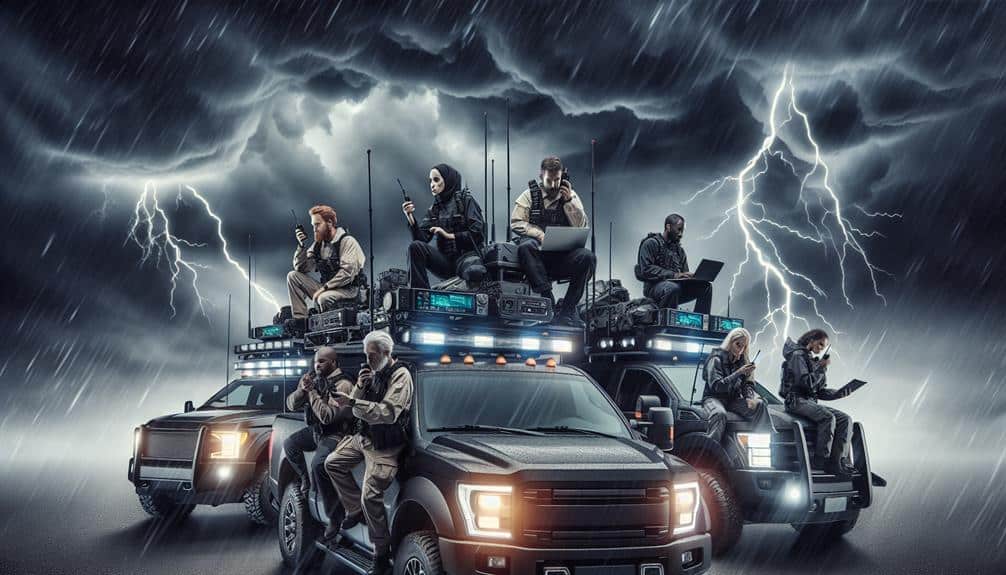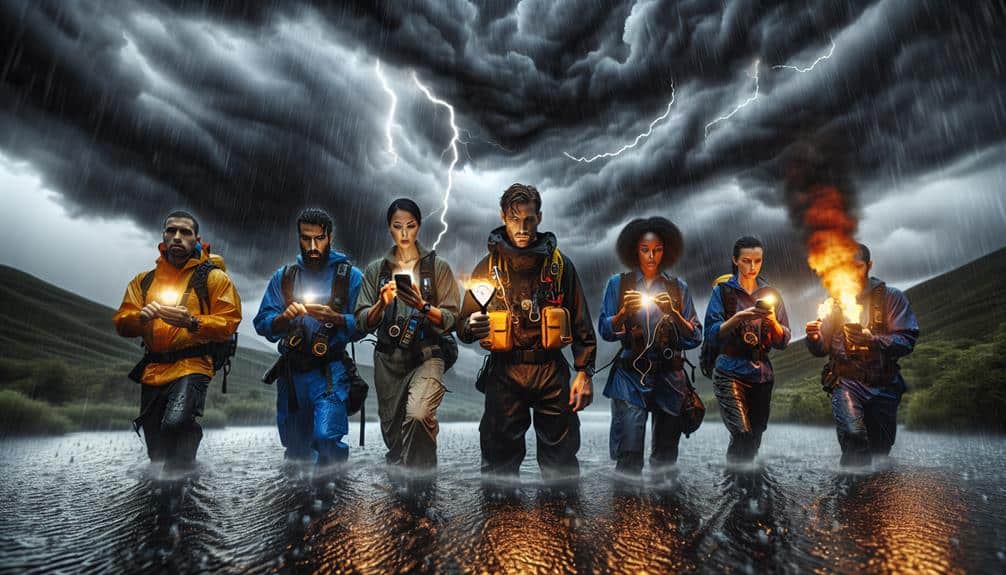In severe weather, we must promptly and dependably connect with emergency services. Using a satellite phone guarantees communication even in extreme conditions. Sending a text message when calls fail is a fast and clear method to convey essential details. Tuning into emergency radio broadcasts keeps us updated and facilitates direct communication with two-way radios. Emergency apps provide real-time advice and share our location with rescuers. To conclude, signaling with flares or lights is crucial for getting noticed by nearby rescuers. These methods help us stay safe and connected. Let's explore how each of these options works in detail.
Key Points
- Use a satellite phone to ensure reliable communication with emergency services in remote areas.
- Send concise text messages to convey essential details like location and injuries when calls fail.
- Utilize emergency radios to receive real-time weather updates and alerts.
- Activate emergency apps for real-time advice, weather alerts, and location sharing with services.
Use a Satellite Phone
During severe weather, we should use a satellite phone to secure reliable communication with emergency services. Unlike traditional cell phones, satellite phones connect directly to satellites orbiting the Earth, securing a reliable connection even when terrestrial networks are down.
When the power goes out and cell towers fail, our satellite phone becomes a lifeline, allowing us to reach emergency services without interruption.
Satellite phones offer a robust solution for emergency communication. They're designed to function in extreme conditions, providing a dependable line of contact when we need it most. Severe weather events often come with unpredictable challenges, and having a satellite phone means we're prepared to face these head-on.
With a satellite phone, we maintain the freedom to communicate regardless of the situation.
Moreover, the reliability of satellite phones makes them indispensable for those of us living in remote areas where conventional networks are often unreliable. By investing in a satellite phone, we secure that our emergency communication remains intact, giving us peace of mind and the ability to act swiftly during critical moments.
The confidence that comes with having a reliable connection can make all the difference in securing our safety and that of our loved ones.
Send a Text Message
When severe weather strikes, sending a text message can be a quick and reliable way for us to communicate with emergency services. Texting often works when phone calls fail, making it one of the best alternative methods during communication blackouts. We can send detailed information about our situation without worrying about dropped calls or poor voice quality.
Text messages also allow us to include essential details that might be lost in a hurried phone call. For instance, we can specify our exact location, describe any injuries, and list emergency contacts who might provide additional information. Many emergency services can utilize location tracking from our text messages to pinpoint our position, expediting their response time.
Using text messaging frees up limited voice channels during high-traffic times, ensuring that more people can reach help. It's also less energy-intensive, which is vital when conserving battery life.
In severe weather, being concise and clear in our messages is necessary. A simple message like 'Need help at [location], [nature of emergency], [number of people]' can make a significant difference. Keeping our messages short and to the point ensures that emergency services receive the information they need to act swiftly.
Utilize Radio Communication
Besides texting, we can also depend on radio communication to stay connected during severe weather emergencies. An emergency radio can be a lifeline when other forms of communication fail. These devices are designed to pick up emergency broadcasts and weather updates, guaranteeing we're always informed about the current situation.
Using an emergency radio effectively requires knowing key communication techniques. First, tune into NOAA Weather Radio or local emergency stations. These channels provide real-time updates and instructions that are vital during severe weather events. We should also familiarize ourselves with the emergency alerts and signals specific to our region.
In addition to receiving information, handheld two-way radios, also known as walkie-talkies, can facilitate direct communication with emergency services and neighbors. These devices don't rely on cellular networks, making them essential when phone lines are down. We should make sure our radios are fully charged and have extra batteries on hand.
Access Emergency Apps
Leveraging emergency apps on our smartphones can provide essential information and assistance during severe weather events. These apps, designed to keep us safe and informed, offer a range of features that can make a significant difference when traditional communication methods fail.
First, emergency chatbots embedded within these apps can guide us through various scenarios. These chatbots offer real-time advice, answer our questions, and help us make critical decisions quickly. They're especially useful when we need instant information but can't wait for human assistance.
Next, weather alerts from these apps keep us updated about changing conditions. Timely notifications about approaching storms, tornadoes, or floods guarantee we're never caught off guard. Knowing what's happening around us allows us to take appropriate action—whether it's seeking shelter or evacuating the area.
Additionally, many emergency apps let us share our location with emergency services, friends, and family. This feature is invaluable when we need to be found quickly.
Using these technological tools empowers us to stay informed and connected, giving us the confidence to navigate severe weather with greater freedom and confidence.
Don't underestimate the power of a well-chosen app in a crisis.
Signal With Flares or Lights

Signaling with flares or lights can be a lifesaver during severe weather conditions. When traditional communication methods fail, flare signals and light beacons become essential tools. These methods cut through the chaos, allowing us to alert rescue teams to our location effectively.
First, let's talk about flare signals. They're designed to be visible from great distances, even in poor visibility. Flares can be handheld or aerial, each serving specific scenarios. Handheld flares are great for signaling nearby rescuers, while aerial flares cover a broader area, increasing the chances of being spotted from afar. We should always follow the manufacturer's instructions to guarantee proper use and avoid accidents.
Light beacons, on the other hand, offer a more sustained signal. Battery-operated or solar-powered, these devices emit continuous light, making them ideal for long-term distress situations. They're especially useful at night or in low-visibility conditions. Placing light beacons in an open, elevated position maximizes their effectiveness.
Frequently Asked Questions
How Can I Prepare an Emergency Kit for Severe Weather?
Think of an emergency kit as our lifeboat in a storm. We stock it with essential supplies like water, food, and first aid. Don't forget to include shelter options like blankets and a weather radio.
What Are the Best Practices for Staying Safe During a Power Outage?
During a power outage, we should guarantee food safety by keeping fridge and freezer doors closed. For communication, let's fully charge devices beforehand and use battery-powered radios or phones to stay informed and connected.
How Should I Create an Emergency Communication Plan for My Family?
Just as we bumped into our neighbors discussing safety, we realized we needed a family meeting. Together, we'll outline a communication plan, ensuring everyone knows contact details and meeting points in case of an emergency.
What Are the Most Reliable Sources for Severe Weather Updates?
We should depend on weather apps, emergency radios, and trusted weather websites for severe weather updates. Social media can also be helpful, but let's verify information from official sources to guarantee its accuracy and reliability.
How Can I Protect My Pets During Severe Weather Emergencies?
In the storm's eye, our pets' safety is paramount. Let's craft solid evacuation plans, ensuring pet safety kits are ready. We'll include essentials like food, water, and medical records, embracing freedom through preparedness.


